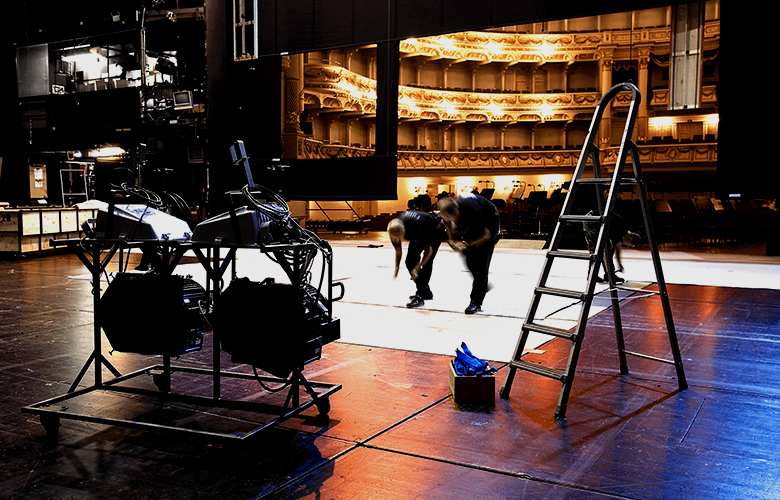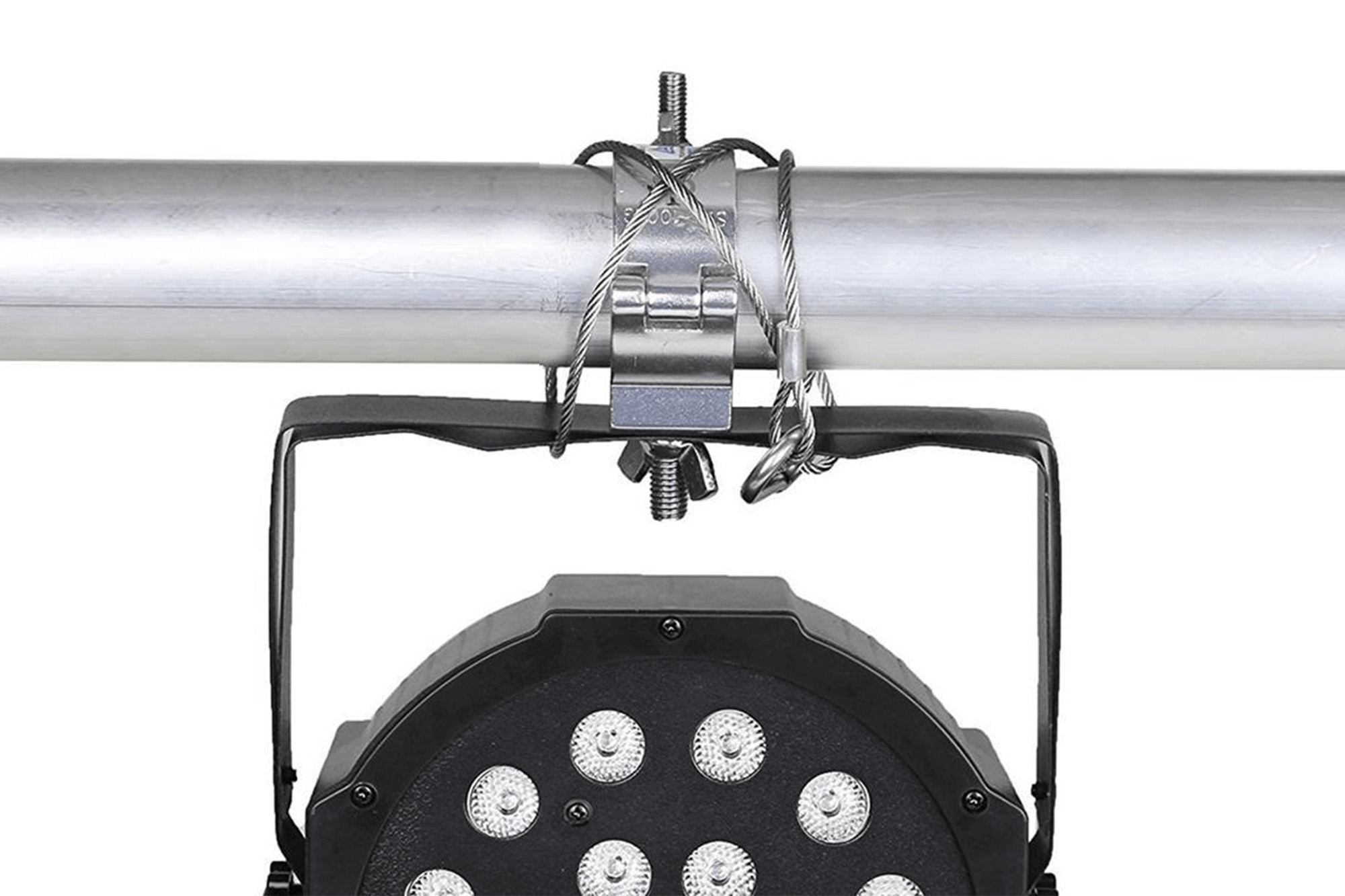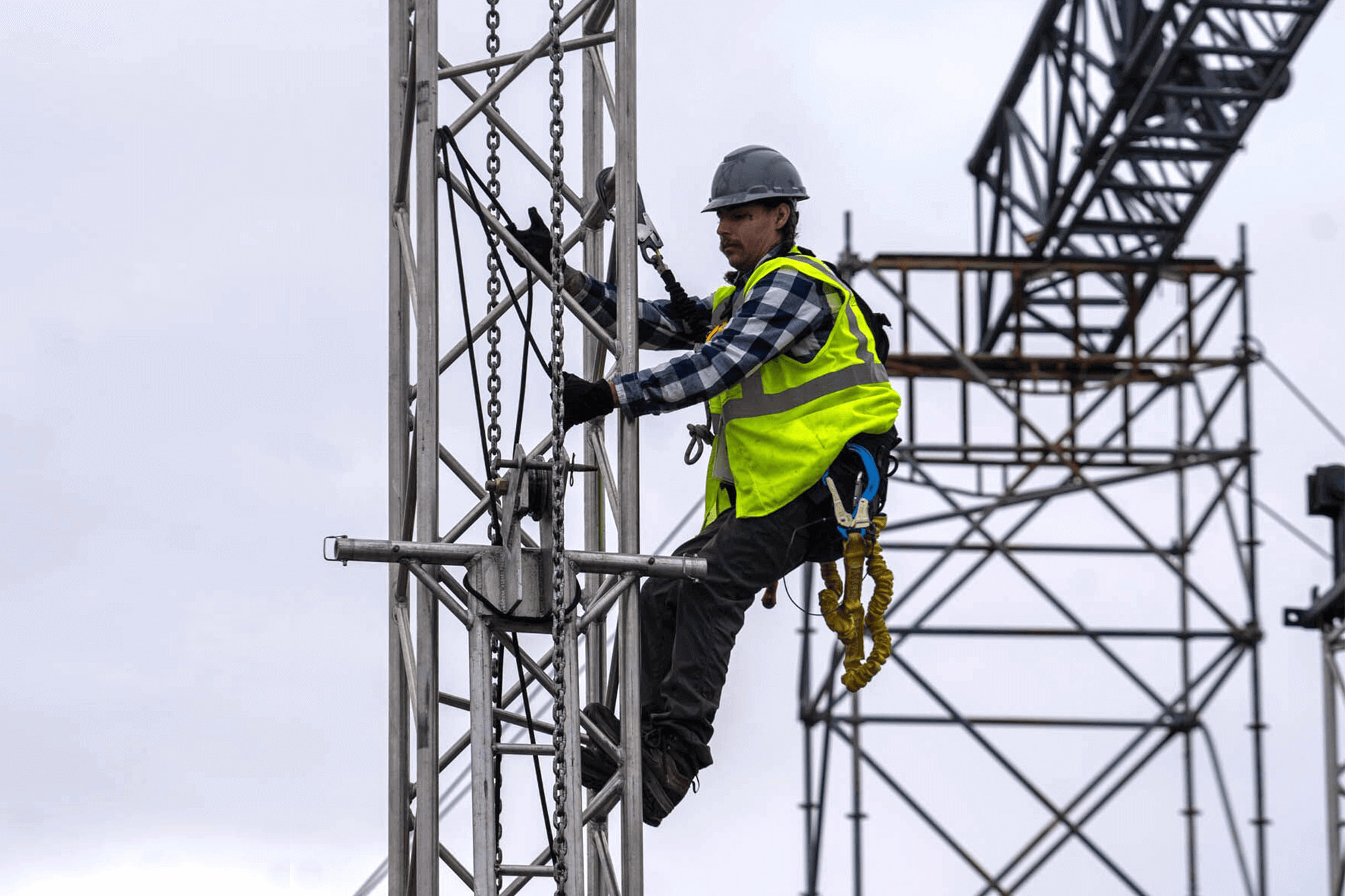
At any kind of live show or event, while performers shine on stage and get a great deal of audience attention, there are many hardworking event staff backstage or in the hall working to make the production happen. As a Gold Supporter of Event Safety Alliance (ESA), and leading staging company in North America for 40 years, we, at Mountain Productions, understand the importance of stage safety. Therefore, we would like to share some important workplace safety basics with those who are new to this industry.
We believe that systems make things safer. No matter if you’re a newbie or experienced professional in setting up events, hanging every light every time in the same order with the same steps, helps to ensure nothing is missed. In the highly stressful environment of the Entertainment Industry, a simple act could be missed. Therefore, working in an organized manner is best practice.
When working with spotlights, always wait a few minutes before removing a lamp or gobo holder. They are still very hot for several minutes after the light has been switched off.
Always treat discharge lamps with extreme care. When they are turned on, these lamps produce harmful levels of UV radiation. While many think that if the lamp is undamaged it isn’t a concern, cracked bulbs can expose stage technicians to UV radiation. Therefore, it is important to protect yourself against this UV hazard by wearing appropriate personal protective equipment (PPE), such as goggles and gloves.
Never rely on just a hook clamp or bolt when mounting a lamp to a tube. Always fit a safety bond or safety chain directly on the bar or suspension point when hanging a lantern. They provide a secondary hanging in the event of primary suspension failure. If the safety bond or chain catches a falling fixture, it must be retired from service as it is no longer safe to use.
Is the safety bond still necessary if you get a whole batch of new, high-quality clamps? The simple answer is yes. In high-stress, no-sleep environments, there can be a number of human failings like not doing the clamp up sufficiently, and not tightening the bolt at the base of the hook clamp that supports the lamp. However, the highest risk is a flown lantern being struck by a piece of scenery fixing or another lantern as it flies past.
Safety bond vs safety chain
While a standard safety chain does not have a rated loading, a safety bond (or safety wire) is approved and rated (from 5kg to 100kg usually). Therefore, a safety bond is the current recommendation in the UK.

We can’t stress safety enough. Our Staging School’s trainers always make sure students gear up safely before engaging in onsite staging and rigging work during training, not to mention a real-world environment where more serious accidents can happen anytime.
HARD HAT: People usually associate hard hats with industrial work and forget other workplaces where head protection is equally vital. A hard hat is generally required while constructing stages or if work is being done overhead. Many theatrical facilities are now seeing hard hats mandated as there is a great chance of head injury from the impact of falling or flying objects.
HARNESS WITH LANYARD: In April of last year, a stagehand fell approximately 60 feet from the Empire Polo Club in Indio, California where he was climbing the stage scaffolding to do some rigging for Coachella Festival. Reports said that he was not clipped into a safety harness when working on the stage. While working in a harness can slow you down, the consequences to your life by choosing not to wear one are not worth the risk. Our team just has a simple goal; to go home safe every day.
There is a common question among riggers ‘’what is the minimum height to use a safety harness?’’ Our OSHA-Certified crew’s answer is ‘’Safety harnesses should be worn whilst carrying out any task where there is a risk of falling.’’
GLOVES: Hand protection is a must for event setting. A pair of rigger gloves can look after our hands when performing strenuous tasks that require all of our attention, such as lifting heavy equipment, climbing and rigging hot lamps.
Our recommendation is to get a pair of proper, snug fit safety gloves that are designed for your work. For example, if you’re mainly responsible for general stage work like load-in, load-out and film/set/scenic, general-use rigger gloves will be sufficient. If, on the other hand, your work involves rope access and theatrical flying, a pair of professional rope gloves are needed to deliver a stronger level of hand protection.
A useful tip for female riggers: Don’t rely on your company for safety gear as they usually provide you with male gloves. Their smallest size may still be baggy for your hands, making you uncomfortable all day and easily causing accidents at work.
WORK TROUSERS: Do you have to crawl around on stage or convention centre floors? If yes, then you need to get a pair of work trousers with good knee pads. These can protect you from getting bruises and allow you to move and squat more comfortably. We also recommend that you avoid baggy trousers that could snag on a ladder and cause you to fall.
FOOTWEAR: Imagine when you’re within 20 feet of a road case or a piece of truss, steel-toed or composite-toe shoes will be something you need the most to protect your toes from heavy impacts. You may also consider high-ankle steel-toe boots or shoes since they offer better ankle support while also saving your toes from impact.

Besides protecting ourselves, taking care of others at work is one of our main considerations in event production. If you work at height, securing your tools with a tool lanyard can ensure that the tools will not pose a hazard to anyone down below if dropped.
This simple safety measure is an easy way to minimize the likelihood of a serious injury – imagine how dangerous a wrench would be if dropped from a height. Even if you’re 100% sure no one is in your working zone, a simple lanyard can save you ample time from going up and down to pick up tools dropped from a height.
Never show off how easily you can climb a ladder with a spotlight in one hand, and a colour filter in your mouth. If possible, use a tower which can be locked in place firmly. If you have to rig a spotlight from a ladder, you need to ensure the ladder is secure, while also having someone steady the ladder when you are working on it.
Every item you intend to work on has to be inspected by a competent person. According to the American National Standards Institute’s document ANSI, E 1.47: Recommended Guidelines for Entertainment Rigging System Inspections;
“The inspector should have a minimum of five years or 10,000 hours of experience including a combination of entertainment rigging systems design, engineering, inspection, installation, maintenance, service, repair, modification and functional testing. Typically, experience only in system operation will not provide suitable experience to inspect entertainment rigging systems.”
While someone is taking care of the whole system inspection, it’s always great we know how to inspect our personal protective gear:
· Webbing or Rope: Inspect for cuts, burns, holes, tears, abrasion and frays
· Hardware (e.g. D-ring and buckle): Inspect for damage, distortion, sharp edges, cracks and corrosion
· Stitching: Inspect for pulled or cut stitches, damaged patterns and abrasion
· Hardhat: Inspect for marks, cracks, impacts, deformations, burns, wear, or signs of chemical products present
Female Stagehand: Equality…But Not Really


I am currently the SEO copywriter of Mountain Productions where I devote my work fulltime to writing event recaps and creating safety rigging content. Working in the largest staging company in North America allows me to experience amazing staging production work and learn best practices for staging environments.
Read Full Profile© 2021 TheatreArtLife. All rights reserved.

Thank you so much for reading, but you have now reached your free article limit for this month.
Our contributors are currently writing more articles for you to enjoy.
To keep reading, all you have to do is become a subscriber and then you can read unlimited articles anytime.
Your investment will help us continue to ignite connections across the globe in live entertainment and build this community for industry professionals.